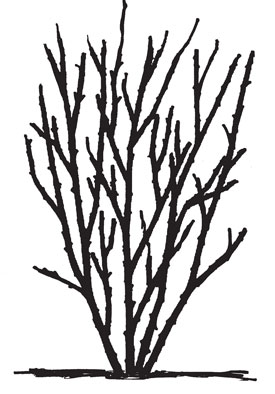Nine timely tasks for beautiful roses
| 1 | Pruning is the key task for July (or August in coldest climates). To help a rose bush harden off before winter, resist the temptation to trim or deadhead in autumn, allowing the last of the blooms to form hips. Remove wood that is dead, damaged or diseased. Then let light and air into the bush by cutting out growth that is crossed or growing towards the centre. Shorten back the remaining branches, cutting on an angle just above an outward facing bud. The spindliest wood is the least likely to produce flowers. |
| 2 | Stimulate new growth on old rose bushes by cleaning up around the crown using a wire brush to remove lichen and old scaly bark. |
| 3 | Say goodbye to poor performers to make room to plant rose varieties better suited to the location, or varieties that are more resistant to pests and disease. Ideally, if planting a new rose in the same spot an old one vacated, dig out the soil and refresh it with new soil from elsewhere in the garden, mixed with some compost and slow release fertiliser. |
| 4 | A good winter clean-up significantly reduces summer pests and diseases whose eggs and spores overwinter under rosebushes in leaf litter and prunings. Clear away the infested debris then finish off with a clean up spray of copper and oil. |
| 5 | Plant something new. Winter is an ideal time to plant new roses, arriving in garden centres in June. Dig a generous planting hole so the roots fit easily without bending. Plant so that the bud union sits at ground level. |
| 6 | Soak the roots of bare root roses (those sold with their roots in protective wrapping rather than in pots) in a bucket of water for 30 minutes before planting. Keep potted roses well watered until you get around to planting them. Then water generously after planting and every day for the next week. New roses love lots of water. |
| 7 | At planting time, trim any damaged roots with secateurs. Trim each branch to just above a bud. Rose bushes are only roughly trimmed by machine before leaving the |
| 8 | Prepare for summer watering. Thirsty roses produce inferior blooms and are far more susceptible to pest and disease problems. In sandy soils, adding compost at planting time helps with water retention. If you have a lot of roses, a soaker hose or drip irrigation is worth installing so you can get the water precisely where needed at the turn of a tap. The most effective watering is slow and thorough soaking, once a week or two, rather than a nightly sprinkle which only encourages shallow root growth. |
| 9 | Roses love sun and fresh air. Winter is an ideal time to move a rose that is struggling in an undesirable location. Poor flowering and leggy growth are signs that your roses want more sun. Pests and diseases thrive in sheltered or humid conditions where roses are close to buildings or overcrowded by other plants. |
15-Jun-2022

Before pruning

After pruning

How to prune above a bud


